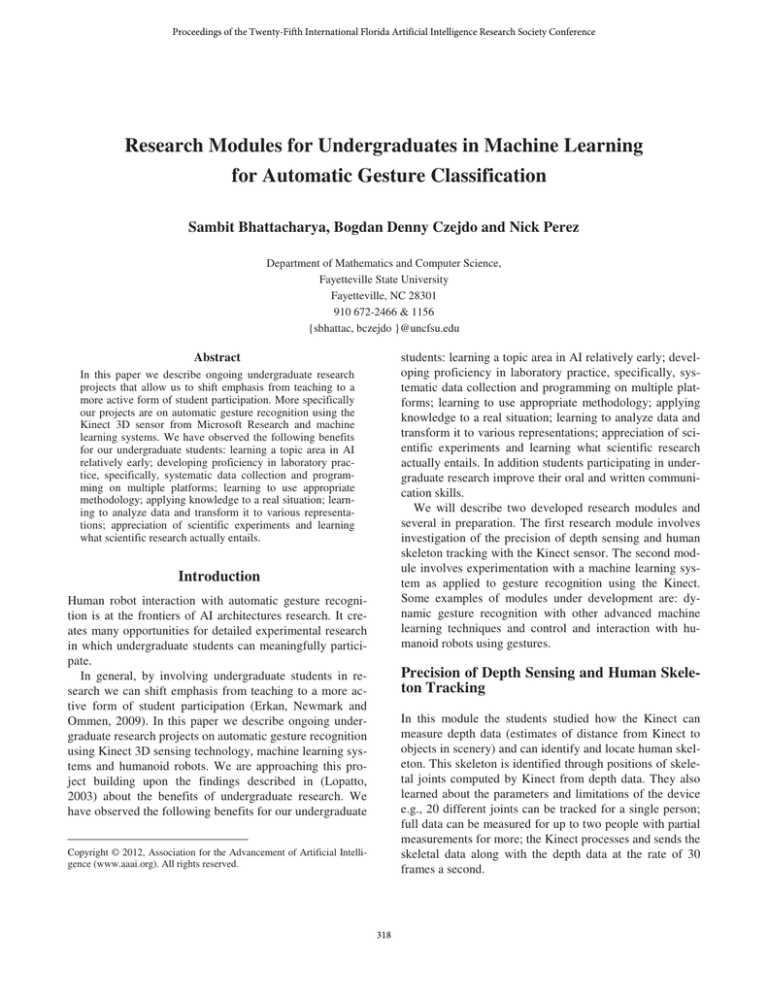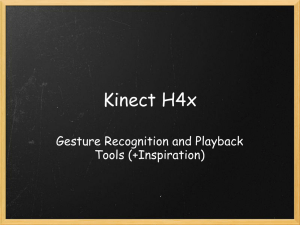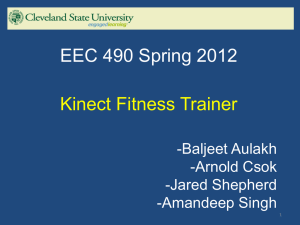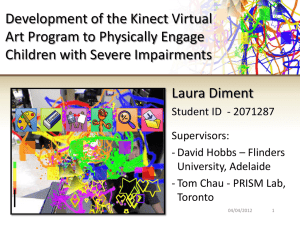
Proceedings of the Twenty-Fifth International Florida Artificial Intelligence Research Society Conference
Research Modules for Undergraduates in Machine Learning
for Automatic Gesture Classification
Sambit Bhattacharya, Bogdan Denny Czejdo and Nick Perez
Department of Mathematics and Computer Science,
Fayetteville State University
Fayetteville, NC 28301
910 672-2466 & 1156
{sbhattac, bczejdo }@uncfsu.edu
Abstract
students: learning a topic area in AI relatively early; developing proficiency in laboratory practice, specifically, systematic data collection and programming on multiple platforms; learning to use appropriate methodology; applying
knowledge to a real situation; learning to analyze data and
transform it to various representations; appreciation of scientific experiments and learning what scientific research
actually entails. In addition students participating in undergraduate research improve their oral and written communication skills.
We will describe two developed research modules and
several in preparation. The first research module involves
investigation of the precision of depth sensing and human
skeleton tracking with the Kinect sensor. The second module involves experimentation with a machine learning system as applied to gesture recognition using the Kinect.
Some examples of modules under development are: dynamic gesture recognition with other advanced machine
learning techniques and control and interaction with humanoid robots using gestures.
In this paper we describe ongoing undergraduate research
projects that allow us to shift emphasis from teaching to a
more active form of student participation. More specifically
our projects are on automatic gesture recognition using the
Kinect 3D sensor from Microsoft Research and machine
learning systems. We have observed the following benefits
for our undergraduate students: learning a topic area in AI
relatively early; developing proficiency in laboratory practice, specifically, systematic data collection and programming on multiple platforms; learning to use appropriate
methodology; applying knowledge to a real situation; learning to analyze data and transform it to various representations; appreciation of scientific experiments and learning
what scientific research actually entails.
Introduction
Human robot interaction with automatic gesture recognition is at the frontiers of AI architectures research. It creates many opportunities for detailed experimental research
in which undergraduate students can meaningfully participate.
In general, by involving undergraduate students in research we can shift emphasis from teaching to a more active form of student participation (Erkan, Newmark and
Ommen, 2009). In this paper we describe ongoing undergraduate research projects on automatic gesture recognition
using Kinect 3D sensing technology, machine learning systems and humanoid robots. We are approaching this project building upon the findings described in (Lopatto,
2003) about the benefits of undergraduate research. We
have observed the following benefits for our undergraduate
Precision of Depth Sensing and Human Skeleton Tracking
In this module the students studied how the Kinect can
measure depth data (estimates of distance from Kinect to
objects in scenery) and can identify and locate human skeleton. This skeleton is identified through positions of skeletal joints computed by Kinect from depth data. They also
learned about the parameters and limitations of the device
e.g., 20 different joints can be tracked for a single person;
full data can be measured for up to two people with partial
measurements for more; the Kinect processes and sends the
skeletal data along with the depth data at the rate of 30
frames a second.
Copyright © 2012, Association for the Advancement of Artificial Intelligence (www.aaai.org). All rights reserved.
318
With such knowledge, our students were challenged to
determine the precision of measurements of depth sensing
and human skeleton tracking using Kinect. This is a very
typical first problem in most scientific research. The precision of measurements need to be determined and its effects
for future experiments need to be studied carefully.
After designing and carrying out several experiments
our students realized the difficulty and complexity of precision determination. Let us look at Table 1 showing the
standard deviation of measurements of Cartesian coordinates of a middle shoulder joint.
Std.
Deviation
5 ft.
x
y
The experiment demonstrated to students the necessity
of careful statistical analysis to understand the noisy characteristics of sensory data.
The students also analyzed the measurements for hand
joint while moving. Some of the results are shown in Table
2. The results can be summarized as follows:
• The error for x and y value for a given pose told us
that y coordinate measurement would not vary
much for a comfortable hand position and have a
significant error for a very uncomfortable position.
z
10 ft.
Table 1. Standard deviation for measurement of Cartesian
coordinates of a middle shoulder joint where each coordinate is in millimeters.
The standard deviation was computed based on 50 measurements for each of 2 distances of the human body from
the Kinect sensor. These measurements were taken when
the middle shoulder joint was stationary but some other
joints were moving. This and other similar results were
very interesting for the students. Let us summarize the results:
• The 3-standard deviations rule for y value told us
that the y coordinate measurement most probably
would not vary more than 3 mm for the distance 5
ft. and not more than 10 mm for the distance of 10
ft. This seemed logical since the larger distance to
the object could cause larger error of measurement.
• The 3-standard deviations rule for the value z, was
completely surprising for students because it told
us that z coordinate measurement could vary 30
mm for the distance 5 ft. and only 20 mm for the
distance of 10 ft. An explanation of these observations was necessary. Analyzing again the experiments the students realized that they are actually
measuring the impact of two variables: precision
of Kinect and instability of human body. The
middle shoulder joint was actually not stationary
but was moving slightly with the movement of
other joints e.g. hands. This was due to involuntary small bodily movements when the human
subject was trying to hold the pose over time.
• The difference between y and z was that y was relatively stable i.e. no movement up and down while
hand was moving. This was due to stability provided by the floor supporting the skeletal frame.
Table 2. The measurements of Cartesian coordinates of a
hand joint shown with the computed error. The vertical axis is distance in millimeters and the horizontal axis is pose
number where the number ranges from most comfortable
to least comfortable type of pose.
Other experiments followed that showed the more detailed
picture of Kinect system precision and the human pose
precision.
Among the experiments let us mention few:
placing the human body against the wall so that we
can get a better stability of some of the human
joints.
using unmovable manikin
changing Cartesian coordinates into spherical coordinates
It was very important for students to see that:
- the design of an experiment can affect precision of
measurement since many variables can affect the experiment.
- a single solution often was difficult to find and that
some type of calibration of results might be the only
way to obtain better results.
- changes of data representation (e.g. from Cartesian to
spherical) change the description of precision of measurement for better visualization.
319
- some obvious solution could unintentionally introduce
other uncontrolled variables in the experiment e.g. placing the human body against the wall caused problems
related with human skeleton tracking through the Kinect system; the students found that the reason for this
was the very small difference in depth between human
body parts and the wall.
the number of poses and its impact on neural network training
the number of joints used in the data set and its
impact on the neural network training
the number of neurons in the hidden layer and its
impact on the neural network training
changing Cartesian coordinates into spherical coordinates in the data set for training neural networks
It was very important for students to see that:
- the training of neural network can produce different results even for the same data set since parts of the data
set are randomly selected for verification and testing.
- sufficient variability in training data is required for the
neural network to generalize well; specifically, changing the whole body position while holding the same
pose was essential for proper automatic recognition of
poses.
- changes in data representation (e.g. from Cartesian to
spherical) can change the results of neural net training.
Gesture recognition with machine learning
In this research module the students learned how to apply
machine learning to the pattern classification problem. The
specific patterns used in our experiments were static gestures or poses of the human body. Students used artificial
neural networks to the automatic classification of
pose/gesture.
One line of experimental enquiry was to find out what
combination of joint data would be optimal for training a
neural network to recognize poses. Students also experimented with different number of nodes in the hidden layer
to investigate the problem of how well the network is able
to generalize based on the same training data. As shown in
the table below, given an 8-pose classification problem,
where data from 5 joints only were used, the network was
able to classify new test cases more accurately when the
number of nodes was increased from 10 to 20. However,
increasing the number of nodes beyond 20 made the classification less accurate due to over fitting.
In general, students could experiment with various machine learning system parameters. To summarize the students experimented with:
Summary and future directions
In this paper we described two developed research modules
for undergraduate research. The first research module involves investigation of the precision of depth sensing and
human skeleton tracking with the Kinect sensor. The second module involves experimentation with a machine
learning system as applied to gesture recognition using the
Kinect.
Table 3. The results for 8-pose classification problem.
320
We are currently developing more research modules
which explore new experimental directions based on and
related to our existing work. Some examples of modules
under development are: dynamic gesture recognition with
other advanced machine learning techniques and control
and interaction with humanoid robots using gestures. Dynamic gesture recognition requires more advanced techniques such as time-compressed templates and timedelayed neural networks (Mitra and Acharya, 2007). We
are planning to use the approach of research through replication of research (Erkan, Newmark and Ommen, 2009).
In this approach undergraduate students will be verifying
results from other pioneering research through experimentation with large volumes of data.
In another future direction we will combine the machine
learning techniques with robot control to achieve human
robot interaction. In this project students will find a novel
application of the previously done research. In addition this
will open the door to applications in social and rehabilitation robotics from which students will be able to choose
their niche for development.
Acknowledgments
We acknowledge the National Science Foundation (award
id: 0959958), internal grants from the Graduate School of
Fayetteville State University, and the Belk Foundation for
supporting this research.
References
Lopatto, D. 2003. The essential features of undergraduate
research. Council on Undergraduate Research Quarterly,
23, 139–142.
Mitra, S.; Acharya, T. 2007. Gesture Recognition: A Survey. IEEE Transactions on Systems, Man, and Cybernetics, Part C: Applications and Reviews, vol.37, no.3,
pp.311-324.
Erkan, A.; Newmark, S.; and Ommen, N. 2009. Exposure
to research through replication of research: a case in complex networks. In Proceedings of the 14th annual ACM
SIGCSE conference on Innovation and technology in computer science education (ITiCSE '09). ACM, New York,
NY, USA, 114-118.
321




